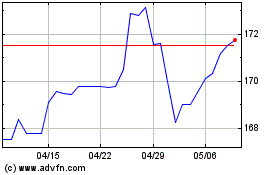Yen Rises After BoJ Keeps Key Rate Unchanged
2024年10月31日 - 12:50PM
RTTF2
The Japanese yen strengthened against other major currencies in
the Asian session on Thursday, after the Bank of Japan left its key
interest rate unchanged as widely expected on Thursday and retained
a cautious approach as political instability and looming U.S.
presidential election added concerns about economic outlook.
In a unanimous vote, the Policy Board decided to maintain the
uncollateralized overnight call rate to remain at around 0.25
percent. This was the highest since late 2008.
The BoJ had ended its negative interest rate policy in March and
last lifted the benchmark rate in July to the current level. So
far, the bank has tightened the policy twice this year.
The bank said it needs to pay close attention to overseas
economies, especially the U.S., and developments in global
financial markets.
While U.S. election due next week added uncertainty surrounding
overseas economies, the ruling Liberal Democratic Party's election
loss added domestic uncertainty.
Inflation forecast for 2024 was maintained at 2.5 percent and
that for 2026 at 1.9 percent.
Investors are now awaiting the post-meeting press conference,
where comments from BoJ Governor Kazuo Ueda are anticipated.
Meanwhile, traders are cautious and remain on the sidelines
ahead of key U.S. economic data due this week and next week's U.S.
presidential election. They also continue to assess the ongoing
geopolitical tensions in the Middle East.
Traders looked ahead to a slew of U.S. economic data, including
personal income and spending, which includes the U.S. Fed's
preferred inflation readings, as well as tech megacap earnings for
directional cues.
In economic news, data from the Ministry of Economy, Trade and
Industry or METI showed that the value of retail sales in Japan was
up 0.5 percent on year in September, coming in at 13.489 trillion
yen. That missed forecasts for an increase of 2.1 percent and was
down from 3.1 percent in the previous month. On a monthly basis,
sales slipped 2.3 percent after rising 1.0 percent in August. For
the third quarter of 2024, sales rose 1.1 percent on quarter and
2.1 percent on year to 41.610 trillion yen.
The METI also said industrial production in Japan was up a
seasonally adjusted 1.4 percent on month in September. That beat
forecasts for an increase of 0.9 percent following the 3.3 percent
contraction in August. On a yearly basis, industrial production was
down 2.8 percent. Upon the release of the data, the METI maintained
its assessment of industrial production, saying that it continues
to fluctuate indecisively.
Data from the Ministry of Land, Infrastructure, Transport, and
Tourism showed that Japan's housing starts decreased for the fifth
straight month in September, though at a slower-than-expected pace.
Housing starts dropped 0.6 percent year-on-year in September, much
slower than the 5.1 percent fall in the previous month. Economists
had expected a decrease of 4.1 percent.
In the Asian trading today, the yen rose to a 2-day high of
165.07 against the euro, a 6-day high of 152.06 against the U.S.
dollar and a 3-day high of 175.86 against the Swiss franc, from an
early 3-month low of 166.09, a 2-day low of 153.59 and nearly a
3-1/2-month low of 177.29, respectively. If the yen extends its
uptrend, it is likely to find resistance around 158.00 against the
euro, 148.00 against the greenback and 170.00 against the
franc.
The yen advanced to a 6-day high of 197.22 against the pound,
from an early low of 198.92. On the upside, 195.00 is seen as the
next resistance level for the yen.
Against Australia, the New Zealand and the Canadian dollars, the
yen climbed to nearly a 2-week high of 99.97, a 6-day high of 90.88
and an 8-day high of 109.30 from early lows of 100.92, 91.82 and
110.39, respectively. The next possible upside target for the yen
is seen around 98.00 against the aussie, 89.00 against the kiwi and
107.00 against the loonie.
Looking ahead, Eurozone flash inflation for October and
unemployment data for September are due to be released in the
European session.
In the New York session, Canada GDP data for August, U.S. weekly
jobless claims data, U.S. PCE price index for September, U.S.
personal income and spending for September and U.S. Chicago PMI for
October are slated for release.
CHF vs Yen (FX:CHFJPY)
FXチャート
から 10 2024 まで 11 2024

CHF vs Yen (FX:CHFJPY)
FXチャート
から 11 2023 まで 11 2024
